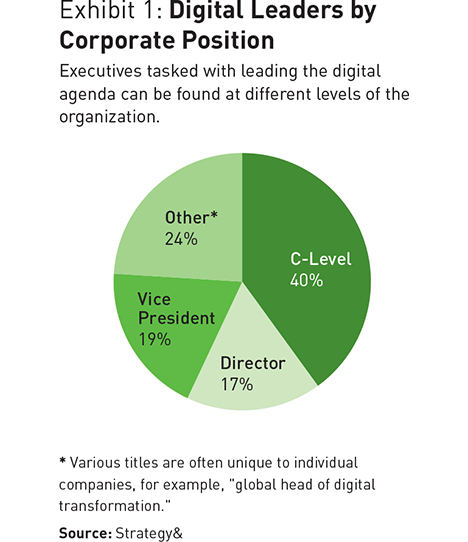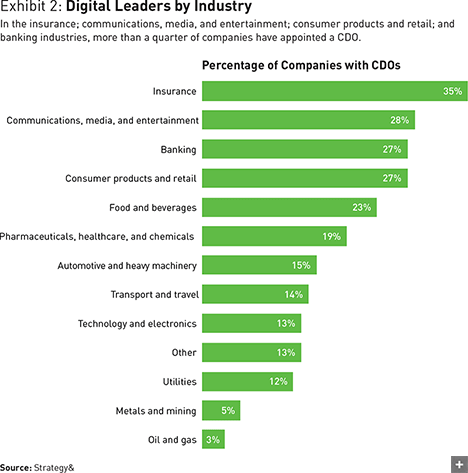The New Class of Digital Leaders
Faced with organizational challenges, more and more companies are hiring an executive to manage their digital transformation.
A version of this article appeared in the Autumn 2017 issue of strategy+business.
A growing number of companies have embraced the need for strong digital leaders. Our 2016 study of chief digital officers (CDOs), which analyzed the presence of such leaders among the world’s 2,500 largest public companies, revealed that 19 percent of these companies have now designated an executive to lead their digital agenda. This number is up from just 6 percent of companies in our 2015 study. And the uptick has gained momentum in recent years: Sixty percent of the digital leaders we identified in our most recent study have been appointed since 2015.
Sixty percent of the digital leaders identified in our study have been appointed since 2015.
Such trends reflect the movement at many companies toward a state of more advanced digital competence. In our experience, it is typically at this stage that top management becomes focused on the need for digital leadership. In the early days of a business, different business units and corporate functions conduct scattershot experiments and pilot programs in hopes of kick-starting their digital efforts. But once a company decides to design a coherent, comprehensive strategy to capture the benefits of digitization, that decentralized approach will no longer suffice.
When it comes to implementing a digital strategy, the new class of CDOs often encounter several major obstacles upon assuming their role: ad hoc digital initiatives spread throughout a large organization, lacking central oversight; a traditional culture that resists change; a gap in the talent required; and legacy systems and structures that threaten to derail their ambitions. The right CDO for your company will have the background and experience to tackle these issues. The mix of requisite skills won’t look the same at every company, but will enable a CDO to lead your organization’s digital transformation, to the point at which fundamental changes in organization, governance, capabilities, business processes, underlying technology architecture, and culture take hold.
We use the title chief digital officer to refer to any executive tasked with putting into practice the digital ambition of his or her company or business unit. This could be a high-level member of the C-suite — a chief digital officer, chief technology officer, or chief information officer, among other roles. However, a company may instead have a vice president or director of digital operations leading the effort. Across industries, we see many of the latter positions represented: The percentage of CDOs who are members of the C-suite hasn’t changed significantly since 2015; it still hovers around 40 percent (see Exhibit 1).
Other findings have also remained constant. Larger companies, for example, are still more likely to have a CDO in place, as are companies based in North America and Europe, and it's still true that most CDOs are men (84 percent in 2016). But there are some notable distinctions among today’s CDOs. Our 2015 study showed that consumer-facing industries such as communications, media, and entertainment; food and beverages; and transportation and travel were leading the way in appointing digital leaders, as they sought to improve their customer experiences, connectivity, and business models. Their leadership position has changed in this year’s study, as other industries — most notably insurance and banking — seek not only to boost their customer-facing activities but also to more fully digitize their internal operations (see Exhibit 2).
We’ve also seen a shift in the background of new digital leaders. In 2015, just 14 percent of CDOs had acquired their primary expertise in a technology field; in 2016, that proportion more than doubled, to 32 percent. Meanwhile, the percentage of CDOs with marketing, sales, and customer service backgrounds fell from 53 percent to 39 percent. And the percentage of technology-oriented CDOs in the C-suite is even higher — 41 percent, compared with 33 percent for marketing and sales CDOs.
These shifts correspond to the circumstances that companies are facing. For example, some companies may be looking to digitize only their customer-facing activities, or just one business unit at a time. The ideal CDO for them may have a great deal of sales or marketing experience in a particular industry, or expertise in a specific technical area. Other companies have greater ambitions for their transformation. Such companies will likely be looking for a digital leader whose background includes not just the customer-facing or operational aspects of digitization, but also experience in managing large-scale change. And now, as more companies reach digital maturity, they need CDOs who can navigate the intricacies of both legacy IT architectures and new digital applications. Getting there requires an executive with a strong background in technology as well as experience in addressing the often fraught political and governance issues involved in approving major technology investments and implementing the new systems.
The CDOs we interviewed for our study tended to have these qualities. Their experiences, their locations on the org chart, and even their specific missions varied. But they are facing similar challenges on their path to digital transformation.
Unify the Digital Agenda
When a new digital leader assumes the role, there may be pockets of digital activity spread throughout the organization. This loose arrangement may work during the early stages of digital transformation, when experimentation is encouraged. But as the company begins to examine digital initiatives in light of a larger strategic goal, a lack of unity can quickly become problematic.
In appointing François Gonczi as the CDO of its customer-facing sales division, EDF, one of France’s largest utility companies, had several goals. The company wanted to get closer to its customers through better digital experiences and data analysis, to rethink and restructure its internal operations, and to devise disruptive new business models that would generate value. These goals represented a major challenge for a traditional company in a risk-averse industry. But Gonczi is well placed to realize those ambitions. Over a decade at EDF, he has worked in network operations, as an economist analyzing M&A opportunities, and as a liaison with the European Union. He thus developed the political skills that now give him an advantage in setting strategy and in promoting the level of innovation necessary to carry it out. “I am well known in EDF to be a good go-between inside the company,” he explains. “Even a very small digitization project requires that you align everybody at the table. My ability to do this isn’t really due to my background but rather to my experience as a ‘politician.’”
Other companies, while having deep experience working in digital, need to revisit their approach because the speed of change has increased. The entertainment giant Warner Bros.’s various divisions have long made use of digital technology to carry out their separate missions. Thomas Gewecke’s appointment four years ago as CDO and executive vice president for strategy and business development (he was formerly president of digital distribution) was, in his words, “a recognition that although these divisions had separate starting points for their digital initiatives, which made a lot of sense historically, there were real advantages to cross-company alignment and coordination in the world that we were going into.”
Every division makes use of customer data to help create and profitably distribute content; part of Gewecke’s strategic mission is to coordinate these efforts by leveraging a consolidated policy framework and technology umbrella to boost results and improve efficiency. “We want to be very fast to market, so we strongly enable and empower every position to operate on a decentralized basis,” says Gewecke. “And at the same time, we make sure that everybody has the help they need to carry out their missions.” The company has a system for sharing resources when multiple divisions need access to similar capabilities, so that units don’t overinvest in distribution platforms, data analysis, security, or new technologies. “My role is to be able to serve as an overarching organizer of our activities in these areas, and ensure that ultimately they all come together to help drive our broader strategy,” he notes. The balance among empowering teams, providing oversight, and avoiding duplication of effort is essential.
Digital leaders need to be able to bring together all the people and business units working on digital initiatives. The concept of unity across the digital agenda is universal: The digital leader needs to be able to set strategy but also ensure buy-in across the organization.
Bridge the Talent Gap
The digital talent gap is widely recognized as a critical challenge for companies seeking transformation. PwC’s most recent Digital IQ study found that the lack of properly skilled teams was considered the number one hurdle to achieving expected results from digital technology investments; 61 percent of respondents identified it as an existing or emerging barrier. In another telling finding, the survey revealed that 46 percent of CDOs are external hires.
The digital leader needs to be able to set strategy but also ensure buy-in across the organization.
The talent challenge was a common topic among the CDOs we spoke with. They need to find the right people to make their digital ambitions a reality. As Warner Bros.’s Gewecke says, “We are all digital. You cannot find a function in our company that is not substantially digital. That means that more and more of our business is software. This requires engineers and developers. How do we think about training? How do we make sure that the workforce has all the right skills? How do we build coding and things like that into talent development? All of those things become relevant for the whole company and every part of the business.”
The need for digital talent is also complicated by the need to pair it with specific industry knowledge. At Blue Shield of California, a San Francisco–based healthcare provider, Todd Walthall, senior vice president of customer experience, says his difficulty hasn’t been finding talented developers, but rather creating the right mix of technologists and people with experience in healthcare. His industry is highly complex, and knowledge of how it is structured is crucial. Much of his job, as he sees it, is to “stir the pot containing both the people who understand healthcare and who have the mind-set to change and embrace what digital has to offer, and all of these ‘skill-position’ players out of other industries” with the know-how to develop the mobile apps the company has released recently and to work out how the company’s business processes should change.
Bridging the talent gap will require companies to identify the types of skills they need and those they lack, and to create a talent strategy that will ensure that their people can put the digital agenda into practice. This will include some combination of training and hiring, as well as bringing the requisite skills in-house through acquisition. Leaders will also need to be aware of cultural inclinations to keep things the way they’ve always been — a mind-set that can slow adoption of new digital initiatives.
Confront Legacy Structures
The very concept of digital transformation recognizes that a company is starting from an insufficiently strong position. And it has the legacy back-office systems and overall organizational structure to show for it. These holdovers can’t always simply be replaced; digital leaders need to know how to work within these constraints as they move to bring the organization forward. Otherwise, they risk bogging down their efforts with some of the very inefficiencies that digital transformation seeks to eliminate. In PwC’s Digital IQ survey, 59 percent of respondents reported that lack of integration of new and existing technologies and data was either an emerging or an existing barrier to achieving their expected results from digital technology initiatives.
One of the biggest challenges CDOs face is how to implement new lean digital applications in an agile way, while dealing with the installed legacy IT systems that are required for running the company. Yves Tyrode, now CDO of the French bank BPCE, was formerly CDO of SNCF, the French national railway company. At SNCF he was in charge of the digital agenda and of legacy IT, and observes that “it is very difficult to manage the daily operations of the legacy IT systems, which are very complex, and at the same time drive the digital agenda.” When he arrived at BPCE, he asked to have responsibility over the “digital factory” that was working on digital developments, but to have the company keep the CIO in charge of legacy IT systems. “I believe now that this bimodal architecture, separating ‘fast IT,’ the digital factory responsible for the development of digital applications, from the legacy ‘core IT,’ which is kept under the responsibility of the CIO, is the right approach to ensure agile and fast change,” he says.
EDF’s Gonczi continues to be burdened with legacy systems that have yet to be transformed or decommissioned. And those old systems bring with them a cumbersome way of organizing IT — a way that seeks to lower risks rather than foster innovation. “The way IT is built and the way IT teams are managed is typically on an individual, application-by-application basis, with one IT team for each application,” Gonczi says. “As an industry, we hate risk, so we put specialists on each application. And they don’t like to change rapidly, because change implies risk.” But digitization demands a more holistic approach, in which applications are more seamlessly linked and more transparent. “If an application is endangered by something new or has to be changed to something new, its entire team feels the heat and the danger,” he notes. This model of organization can slow change down to a crawl. A concerted effort to realign how these teams think and work is the only way to speed things up.
For Blue Shield’s Walthall, process change is critical in managing legacy IT. Around the time of his arrival, Blue Shield of California was experiencing rapid growth in membership, yet the company still conducted business using many manual processes that were never designed to scale up. Fixing the problem incrementally was not on the table. “We had processes that were never written down,” he says. “Things like, ‘Call Suzy if X occurs.’ But what happens when Suzy is on vacation? It doesn’t get done.”
Blue Shield has since migrated all its members to a new, faster system, an effort that has significantly restructured and automated everything from issuing ID cards to processing claims. That process is a tribute to Walthall’s ability to work with the company’s IT function — which all too often can be another source of pain as companies digitize. “One of our strengths is the incredible collaborative relationship we have with the CIO,” he says.
Every digital leader of a large organization will be forced to balance new digital initiatives with the legacy IT system the company has in place. In some cases, separating new from old will work best; in others, process changes can help the two coordinate more seamlessly. How CDOs approach this challenge will depend on a number of factors, key among them the CDO’s place within the hierarchy, and the organization’s culture. Some may be able to set the terms when being hired; others will need to work within established constraints.
Find the Right Digital Leader
When hiring a digital leader, companies must consider not just the individual’s background and expertise, but also his or her position within the organization and the governance mechanisms from which he or she will derive the responsibility and authority needed to carry out the mission. Of course, such considerations come into play whenever a large company hires any top executive. The role of the CDO, however, is a relatively new one, and many companies are still trying to figure out what works.
Every digital leader will be forced to balance new digital initiatives with the legacy IT system the company has in place.
Moreover, what works won’t be the same at every company or in every industry. And even within a company, the role may need to evolve over time. As a company’s digital ambitions take shape, the CDO may have to be take on more or different responsibilities, as well as oversee different groups or functions. At the same time, the evolution and growing sophistication of technologies enabling digital transformation can affect what skills are required of digital leaders.
True digital leadership is the ability to guide a company through these changes, all while keeping an eye on the big picture. The challenges of digital transformation are not insignificant, but neither is the promise. Although there’s no map for a digital journey that every company can follow, understanding where you are and where you want to go can help you identify the right person to guide you.
Reprint No. 17305
Author profiles:
- Pierre Péladeau is a leading practitioner in digital transformations for Strategy&, PwC’s strategy consulting group. Based in Paris, he is a partner with PwC France. He supports executives working on digital strategy in the telecommunications, technology, energy, utilities, aerospace, and retail sectors.
- Mathias Herzog is a leading practitioner in digital strategies for Strategy&. Based in Seattle, he is a principal with PwC US. He primarily focuses on the technology, media, and retail sectors.
- Olaf Acker is a thought leader in digital services for Strategy&. Based in Frankfurt, he is a partner with PwC Germany and leads PwC Digital Services for Europe, the Middle East, and Africa. His focus is technology and digital transformation.
- Also contributing to the article was Kai Müller, senior research and knowledge manager with PwC Germany.







